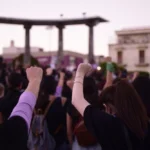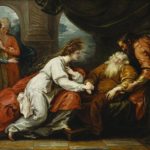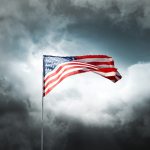Published April 8, 2013
“You can’t say that a man like Church, or even Albert Bierstadt, who was, after all, an import — he wasn’t born in America — you can’t say that they painted in any way except in an American way. That involved grandeur, extravagance, sheer size.” These words from the English critic and historian Paul Johnson summarize perfectly many of the notable works on display in the Smithsonian American Art Museum’s The Civil War and American Art, an exhibition timed to coincide with the sesquicentennial of the war. (The exhibition closes on April 28. It will be at the Metropolitan Museum of Art in New York from May 27 to September 2.)
One gallery alone, filled with large-scale mid-19th-century masterpieces, justifies a visit. Here is the essence of what Johnson calls “the American way.” Albert Bierstadt’s Looking Down Yosemite Valley, California (1865) was painted the year the Civil War ended and as Americans began to look westward. In this breathtaking view through Yosemite’s towering peaks toward the luminescent, limitless horizon, Bierstadt envisions the yet uncharted splendor of the American future.
Nearby, Frederic Church’s The Icebergs (1861), a vast, dazzling, bone-chilling portrayal of leaden skies, mountainous icebergs, and multi-hued snow, evokes the Romantic dread of the destructive powers of nature. In a neighboring painting of a markedly different type, Cotopaxi (1862), he depicts an Andean volcano. Here the imagery is of heat, fire, ash, and a looming, lurid red sky, yet this painting too evokes the primeval powers of The Icebergs. (Another painting by Church in this exhibition, 1861’s Our Banner in the Sky, disappoints: Painted at the outset of the war, it portrays red clouds, blue sky, and white stars in the shape of the American flag, and demonstrates how a great artist can be banal when straining to bend his art to a topical or political purpose.)
There are many other fine landscapes in the exhibition, most notably those by Sanford Robinson Gifford, but the most compelling works are from the brush of Winslow Homer, perhaps the most American and the most gifted painter of our 19th century. The exhibition also features several of Homer’s depictions of the war, which he covered for the popular magazineHarper’s Weekly. Trained as an illustrator, like those quintessentially American artists Howard Pyle and Norman Rockwell, Homer knew how to make paint tell a story. But more than that, his works furnish a subtle, contemplative glimpse of the war unequaled by his contemporaries.
Home, Sweet Home (circa 1863) depicts Union soldiers bivouacked near Fredericksburg, lost in melancholy as they listen to the distant sound of a military band playing the popular song of the same name, a tune beloved of President Lincoln: After hearing it in the White House, he thanked the singer, who noted that the president’s “voice was husky and his eyes were full of tears.”
Homer’s The Briarwood Pipe (1864) portrays two members of the Fifth New York Infantry, attired in their exotic Zouave blue jackets and bright red pants (which made them excellent targets for Confederate soldiers). The title comes from the pipe one of them carves as they converse before their tents, seen in the background against a cloud-splashed sky. Loosely painted with just a few colors, the picture focuses not on the feats of these dashing troops but on a peaceful interlude between episodes of war’s carnage.
While Homer does paint images of combat — Sharpshooter (1863), derived from one of his illustrations in Harper’s Weekly, shows a sniper taking aim — it’s his Veteran in a New Field (1865), a complex meditation on the war, that is the most arresting painting in the exhibition. In a stark composition of loosely painted bands of sky, and rows of standing wheat (many Civil War battles were fought in wheat fields) more suggested than depicted, Homer skillfully tells his story by a sophisticated handling of form, autumnal color, and light. The veteran, his uniform jacket cast on the ground, occupies the middle of the canvas, his white shirt the most brilliant part of an otherwise sober palette. As he scythes the stalks of grain that fall behind him, an action that hauntingly evokes the archetypal image of the grim reaper, the veteran faces a bountiful harvest and a resurrection of life after the butchery that ended the year Homer painted this masterpiece. The simplicity and mystery of this quiet scene is ineffably moving.
Besides the Churches, Bierstadts, and Homers, there is a vast array of works, including paintings of fortifications and a fascinating depiction of a Rebel submarine, by the Confederate soldier/artist Conrad Wise Chapman. The photographs of the war by Alexander Gardner and George N. Barnard are familiar but nonetheless important, examples of the new medium of photography, which would forever change the face of war by recording the bloated bodies of the fallen, blasted landscapes, and great cities reduced to rubble.
Unfortunately, the exhibition, while filled with notable paintings, does little to help its visitors appreciate the works. For instance, there is no obvious thematic or chronological spine to follow. Also, confusingly, there are two entrances to the exhibition, with identical introductory wall texts, so it’s unclear where it begins or ends; and there’s no brochure or introductory film to provide even the most basic orientation.
Many of the paintings are labeled only with the artist’s name and dates, and the date and title of the work. This is of course preferable to the series of long, tendentious explanatory labels that serve as soapboxes for the facile, politically correct postmodernism that is typical of today’s museum world — and that are to be found in the five-pound book ($65 hardcover, $45 paperback) accompanying the exhibition. Here one reads that Eastman Johnson’s Christmas-Time, The Blodgett Family (1864) is not really about what the artist painted — a cozy domestic scene of a family at Christmastime — but is, instead, an encapsulation of the “murky and conflicting attitudes toward African Americans, including free blacks and soldiers, that prevailed even among the more genteel and liberal supporters of the Union cause.”
Similarly, one might have thought that Homer’s Near Andersonville (1865–66), a portrait of a slave woman standing in the doorway of a simple house watching Union soldiers being marched off to the notorious penal camp at Andersonville, Ga., is a somber but captivating painting that, like other works by this artist, appeals to us because it is superbly mysterious. But the curator is having none of this, because she knows with certainty that it is really about “this woman’s resolve, about her ability to step forward and choose between safe retreats and daring prospects” and that “Homer has made her a symbol for all of her race.”
The book is loaded with such questionable interpretation and psychobabble, and will offer little enlightenment to the museum-goer, who has already been cheated by the skimpy labeling of the exhibition itself. These decisions are so dubious that it’s fair to ask how the exhibition has advanced the museum’s role as a federally funded institution meant to serve the nation’s citizens. Museum officials will be quick to point out that foundations and individuals have underwritten this exhibition — but you and I are helping to pay for the staff’s salaries, the maintenance of the museum’s extremely valuable permanent collection, and the upkeep of a large physical plant, which has recently undergone a multimillion-dollar restoration. And, of course, the museum and its contributing foundations don’t pay taxes.
But there’s another federal subsidy bankrolling the museum’s operation: the Arts and Artifacts Indemnity Program, a $10 billion low-deductible insurance policy designed to underwrite the value of foreign and domestic loans for museum exhibitions in the United States. Run by the National Endowment for the Arts, this program has flown under the radar since its establishment in 1975, probably because it puts the American taxpayer at risk for billions in insurance claims.
Under the program’s domestic-indemnity provision, which indemnifies The Civil War and American Art, only exhibitions composed of objects from United States collections with an insurance value of at least $75 million can qualify for support. The program therefore encourages prodigiously expensive shows that can be mounted only by major museums in large cities.
Now, the wisdom of such generous federal support to museums visited by only a fraction of the public is certainly an open question. But, like it or not, the government is in the cultural-support business big time, and that is precisely why the Smithsonian American Art Museum has an obligation to serve those taxpayers who keep its doors open, something it has woefully failed to do in The Civil War and American Art.
Bruce Cole, a former chairman of the National Endowment for the Humanities, is a senior fellow at the Ethics and Public Policy Center.










